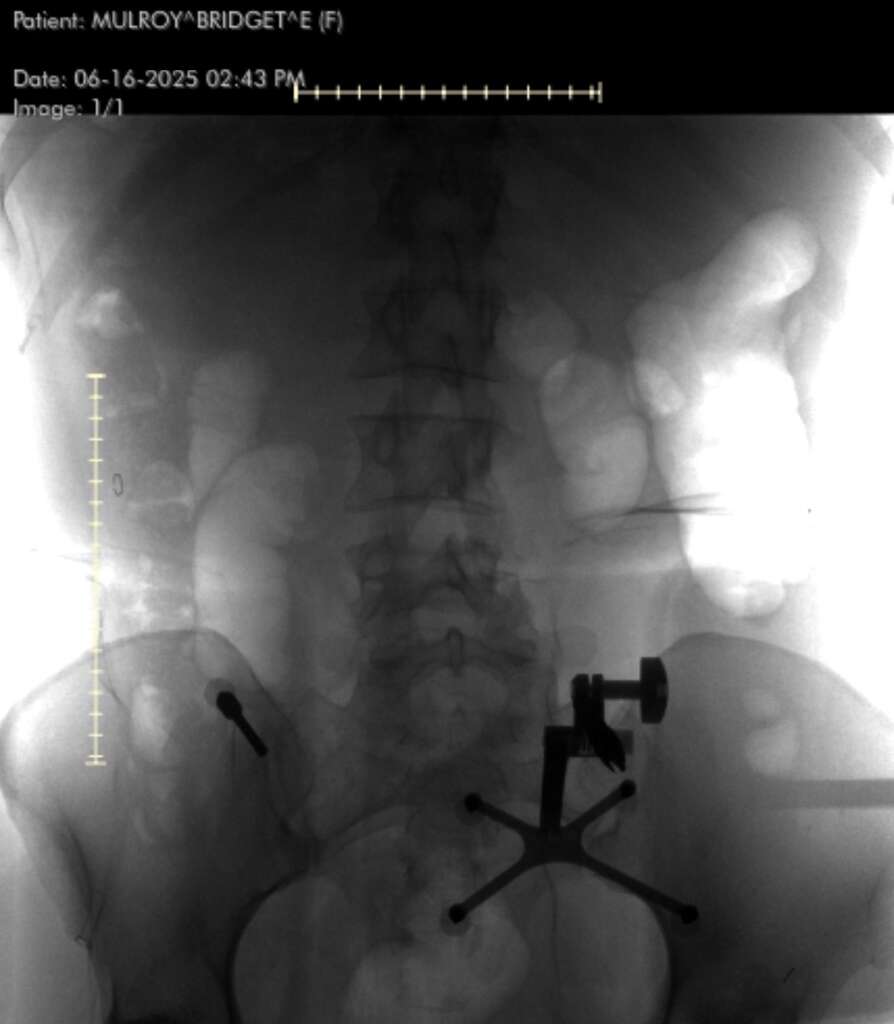Share This Article
A Spine Surgery Survivor’s Journey Through Trauma, Trust, and the Science of Hope
You don’t think about your spine—until it’s the only thing you can think about.
That moment came for me in the wreckage of a car crash that shattered more than just bone. One minute, I was driving. The next, I was broken—inside and out. I had sustained an unstable lumbar fracture, the kind of injury that changes everything. My spine—the structural core of my body—was compromised. I couldn’t sit up. I couldn’t walk. I didn’t know if I ever would again.
Enter Dr. Wylie Lopez, MD, an orthopedic spine surgeon who specializes in moments like this. To him, this wasn’t just surgery. It was stabilization. Preservation. The opportunity to reclaim what had been violently taken from me.
And he did it—within 24 hours.
Holding a Life in His Hands

Image Credit: Dr. Wylie Lopez
When I asked Dr. Lopez what it feels like to literally hold someone’s ability to walk—or even live—in his hands, he didn’t romanticize it.
“It’s one of the most stressful parts of what I do,” he said. “There’s a lot of uncertainty in medicine, especially with trauma. Even a technically perfect job can have an uncertain recovery. These are the situations that keep us up at night.”
But that pressure, he explained, is exactly why mastery matters.
“I focus on the things I can control—my technique, my decision-making, my hands.”
Those hands saved my life.
Breaking the Myths Around Spine Surgery
Before my surgery, I was terrified. I had heard all the horror stories—paralysis, chronic pain, botched fusions, addiction to pain meds. But Dr. Lopez sees those narratives as outdated and oversimplified.
“Spine surgery has reached a technological revolution,” he said. “We now have robotics, augmented reality, and minimally invasive techniques that make even complex surgeries safer and outcomes better.”
One of the biggest myths? That physical therapy doesn’t work and that surgery is inevitable.
“About 80% of my patients get better with PT, exercise, weight loss, and managing depression,” he explained. “I operate on the other 20%. Surgery is often the last line of defense.”
But in trauma cases like mine, that calculus changes quickly.
The Science of Emergency Stabilization
“When I realized your fracture was unstable,” Dr. Lopez told me, “I knew you wouldn’t be able to mobilize without internal stabilization. Letting you try to walk could’ve worsened the fracture, caused spinal deformity, or led to nerve damage and chronic pain.”
Instead of using an external brace, Dr. Lopez used hardware—screws and rods—to create internal support.
“Technically, you didn’t have a spinal fusion,” he clarified. “You had spinal instrumentation and stabilization. A fusion requires bone grafts and biologic processes to encourage new bone growth.”
What he gave me, though, was just as powerful: a structurally sound spine—and a second chance at mobility.
Inside the Operating Room
When Dr. Lopez described the actual procedure, I was floored by the precision involved.
He performed a minimally invasive posterior lumbar instrumentation from L2 to L5. That means he made small incisions guided by real-time navigation using a machine called the O-arm—a rotating intraoperative CT scanner. A localizing pin in my pelvis communicated with a computer, which told him exactly where to place each screw.
“Once the screws are inserted,” he explained, “I use an X-ray to place the rods. The key decisions involve knowing which levels to include, ensuring screw trajectory is perfect, and having a plan if something doesn’t go right.”
I asked: What happens if something doesn’t go right?
“If a screw is placed too far forward, it could hit major blood vessels. That could lead to death or severe disability.”
He didn’t say this to scare me—he said it because that’s the level of consequence spine surgeons face every time they step into the OR.
Minimally Invasive, Maximally Transformative
So what does “minimally invasive” actually mean?
“It means reducing collateral damage,” Dr. Lopez said. “We avoid dissecting the large muscles of the spine. That means less blood loss, less post-op pain, and faster recovery. The same applies to endoscopic and lateral-based approaches.”
Within 24 hours of surgery, I was standing. Walking. Slowly, yes—but it felt miraculous.
“That’s because the spine was no longer unstable,” he said. “Once you fix the problem mechanically, movement becomes tolerable again. And the body is incredibly resilient.”
The Mental Game of Recovery
Of course, recovery isn’t just physical—it’s emotional.
“The mental part is half the battle,” Dr. Lopez told me. “People with depression have worse outcomes, even with the same surgery. I encourage positivity and resilience because it truly impacts healing.”
In my case, he said my recovery was above average. Why?
“You’re young, healthy, and motivated. You also have a strong pain tolerance, which made physical therapy more manageable.”
He also emphasized how crucial pre-injury fitness and mental health are in predicting outcomes.
“Most of my patients return to a normal life, as long as they follow restrictions and manage risk factors like smoking or uncontrolled diabetes.”
Pain, Opioids, and the Balance of Trust
Pain management is one of the most delicate parts of spine surgery recovery. The pain is real—but so is the fear of opioid dependency.
“There needs to be a solid post-op pain plan,” he said. “Clear boundaries, expectations, and sometimes a narcotics agreement. But we also leave room for compassion. If someone is suffering, we work with them.”
A Future Built on Titanium—and Hope

Image Credit: Bridget Mulroy
I asked him what becomes of all the hardware—the screws, rods, and implants—once the spine heals.
“They support the body through the healing process,” he said. “Once bone growth stabilizes the segment, it’s like the hardware isn’t even there. But if a surgery doesn’t heal properly, the hardware can become loose, break, or even get infected.”
And what about those rumors of becoming a “human barometer”?
“We hear that a lot,” he laughed. “There’s no definitive proof, but barometric pressure may affect tissues post-op. The jury’s still out.”
If You’re Afraid…
To anyone frozen by the fear of spine surgery—especially those suffering in silence from chronic pain—Dr. Lopez had this to say:
“I try not to push. My job is to educate. If they ask what I’d do, I imagine they’re my own parent and answer with that in mind.”
That’s what makes him special. Not just his surgical skill—but his humanity. He’s not just cutting bone—he’s restoring lives.
My Life After Surgery
Today, I live without fear of collapse. Without the dull, grinding ache that once defined my every movement. I walk. I travel. I live. And I owe that to the science of modern spinal medicine—and to Dr. Wylie Lopez, whose steady hands held my future.
He says he remembers every patient he’s treated with spinal cord injury and paralysis. He carries them with him.
I carry him with me, too—not just in the screws and rods that stabilized my spine, but in the faith I now have in my body, my healing, and what’s possible when medicine meets miracle.
If you’ve been told your back is broken—or that your pain has no solution—know this:
There are people like Dr. Lopez who dedicate their lives to rebuilding what feels shattered beyond repair.
There’s hope. There’s healing.
And yes, there’s life on the other side of broken.




